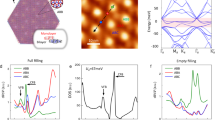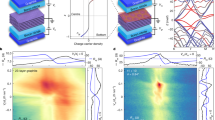Abstract
Moiré superlattices created by the twisted stacking of two-dimensional crystals can host electronic bands with flat energy dispersion in which enhanced interactions promote correlated electron states. The twisted double bilayer graphene (TDBG), where two Bernal bilayer graphene are stacked with a twist angle, is such a moiré system with tunable flat bands. Here, we use gate-tuned scanning tunneling spectroscopy to directly demonstrate the tunability of the band structure of TDBG with an electric field and to show spectroscopic signatures of electronic correlations and topology for its flat band. Our spectroscopic experiments are in agreement with a continuum model of TDBG band structure and reveal signatures of a correlated insulator gap at partial filling of its isolated flat band. The topological properties of this flat band are probed with the application of a magnetic field, which leads to valley polarization and the splitting of Chern bands with a large effective g-factor.
Similar content being viewed by others
Introduction
A moiré superlattice with flat electronic bands was first discovered by stacking two layers of graphene on top of each other at a precise angle1,2,3. The flat band in magic angle twisted bilayer graphene (MATBG) emerges from the interplay between interlayer hybridization and monolayer graphene’ electronic structure and displays a plethora of correlated and topological phenomena. At partial band filling, MATBG shows a cascade of correlated insulating and superconducting phases, the underlying mechanisms of which are still being investigated3,4,5,6,7,3a. First, we highlight that changes of do** in TDBG caused by the VSiG results in three clear jumps of the vHs marked by dashed white lines, indicating the Fermi energy is passing through a band gap. From these jumps, we identify the gate voltages corresponding to CNP (VSiG = −3.5 V), full occupancy of the conduction band (72.5 V), and full occupancy of the valence band (−79.5 V). The appearance of CNP near zero gate voltage reveals that samples are not doped by impurities or by a significant work function difference between the sample and the STM tip. Furthermore, we find the gate voltage ranges required to occupy the conduction band and the valance band are identical: \(\Delta {V}_{{\rm{SiG}}}\) = 76 V, which is also consistent with the carrier density needed to fill a moiré band of the 1.48° TDBG: nS = 5.08*1012 cm−2 based on a parallel plate capacitance model (see Methods). These observations indicate that our sample is pristine, and our measurements are free from artifacts of tip-induced band bending, which was a concern in early STM studies of MATBG7,7). We observe clear jumps of spectral features when the Fermi energy crosses the full filling gaps. In the case that the tip does not have any gating effect, these jumps would occur at the same back gate voltage independent on bias voltage. However, tracing the full filling jumps, we notice a small change of fulling filling gate voltage depending on the bias voltage (Supplementary Fig. 7). From the slope of the discontinuity line, we can estimate the gating efficiency ratio between the tip and the back gate, which find 300 mV of the tip bias gating is comparable to 1 V of back gate voltage.
Details on half-filling states
One may notice the half-filled states in Fig. 4 does not occur exactly at half filling. While we do not know the exact cause of this, it could be a result of nonlinear gating effect caused by mobile charged impurities inside the hBN or tip-induced band-bending effect8. We also cannot rule out the possibility of the correlated insulating state occurs slightly away from half filling in large twist angle TDBG devices. It is worth noting in previous transport studies, although the correlated insulator is commonly observed at half filling, sometimes it occur a little off from exact half filling23.
Discussion on Supplementary Figs. 2 and 3
In Fig. 4a–c and Supplementary Figs. 2 and 3, we show several GT-STS measurements that provide information on the variation of such measurements at different areas of the same device as well as different locations within the moiré unit cell. Supplementary Fig. 2 shows a different type of data showing the signatures of correlations in the broadening and the visibility of the gap at the Fermi level in C1 can be different when measured on different locations or with different tip conditions. In Supplementary Fig. 3, we include more GT-STS measurements presented together with STM topographs that show areas 1–4. The location of the corresponding measurements within the unit cell are marked on these topographs (Supplementary Fig. 3a–d). Spectrums in Supplementary Fig. 2 (Supplementary Fig. 3h), which shows two peaks of C1 band, with one peak crossing the Fermi level and further split around the half filling, appear to the very different from other data set (Supplementary Fig. 3a–c). The difference could be caused by the different locations where the data is taken, but it could also be caused by anomalous tip condition in acquiring Supplementary Fig. 2.
Data availability
The data that support the findings of this study are available from the corresponding author upon reasonable request.
References
Suárez Morell, E., Correa, J. D., Vargas, P., Pacheco, M. & Barticevic, Z. Flat bands in slightly twisted bilayer graphene: Tight-binding calculations. Phys. Rev. B 82, 121407 (2010).
Bistritzer, R. & MacDonald, A. H. Moiré bands in twisted double-layer graphene. Proc. Natl Acad. Sci. USA 108, 12233–12237 (2011).
Cao, Y. et al. Correlated insulator behaviour at half-filling in magic-angle graphene superlattices. Nature 556, 80–84 (2018).
Cao, Y. et al. Unconventional superconductivity in magic-angle graphene superlattices. Nature 556, 43–50 (2018).
Yankowitz, M. et al. Tuning superconductivity in twisted bilayer graphene. Science 363, 1059–1064 (2019).
Lu, X. et al. Superconductors, orbital magnets and correlated states in magic-angle bilayer graphene. Nature 574, 653–657 (2019).
Choi, Y. et al. Electronic correlations in twisted bilayer graphene near the magic angle. Nat. Phys. 15, 1174–1180 (2019).
**e, Y. et al. Spectroscopic signatures of many-body correlations in magic-angle twisted bilayer graphene. Nature 572, 101–105 (2019).
Jiang, Y. et al. Charge order and broken rotational symmetry in magic-angle twisted bilayer graphene. Nature 573, 91–95 (2019).
Kerelsky, A. et al. Maximized electron interactions at the magic angle in twisted bilayer graphene. Nature 572, 95–100 (2019).
Wong, D. et al. Cascade of electronic transitions in magic-angle twisted bilayer graphene. Nature 582, 198–202 (2020).
Zondiner, U. et al. Cascade of phase transitions and Dirac revivals in magic-angle graphene. Nature 582, 203–208 (2020).
Stepanov, P. et al. Untying the insulating and superconducting orders in magic-angle graphene. Nature 583, 375–378 (2020).
Saito, Y., Ge, J., Watanabe, K., Taniguchi, T. & Young, A. F. Independent superconductors and correlated insulators in twisted bilayer graphene. Nat. Phys. 16, 926–930 (2020).
Arora, H. S. et al. Superconductivity in metallic twisted bilayer graphene stabilized by WSe2. Nature 583, 379–384 (2020).
Liu, X. et al. Tuning electron correlation in magic-angle twisted bilayer graphene using Coulomb screening. Science 371, 1261–1265 (2021).
Sharpe, A. L. et al. Emergent ferromagnetism near three-quarters filling in twisted bilayer graphene. Science 365, 605–608 (2019).
Serlin, M. et al. Intrinsic quantized anomalous Hall effect in a moiré heterostructure. Science 367, 900–903 (2020).
Nuckolls, K. P. et al. Strongly correlated Chern insulators in magic-angle twisted bilayer graphene. Nature 588, 610–615 (2020).
Wu, S., Zhang, Z., Watanabe, K., Taniguchi, T. & Andrei, E. Y. Chern insulators and topological flat-bands in magic-angle twisted bilayer graphene. Nat. Mater. https://doi.org/10.1038/s41563-020-00911-2 (2021).
Saito, Y. et al. Hofstadter subband ferromagnetism and symmetry-broken Chern insulators in twisted bilayer graphene. Nat. Phys. https://doi.org/10.1038/s41567-020-01129-4 (2021).
Shen, C. et al. Correlated states in twisted double bilayer graphene. Nat. Phys. 16, 520–525 (2020).
Liu, X. et al. Tunable spin-polarized correlated states in twisted double bilayer graphene. Nature 583, 221–225 (2020).
Cao, Y. et al. Tunable correlated states and spin-polarized phases in twisted bilayer–bilayer graphene. Nature 583, 215–220 (2020).
Burg, G. W. et al. Correlated insulating states in twisted double bilayer graphene. Phys. Rev. Lett. 123, 197702 (2019).
He, M. et al. Symmetry breaking in twisted double bilayer graphene. Nat. Phys. 17, 26–30 (2021).
Zhang, Y. H., Mao, D., Cao, Y., Jarillo-Herrero, P. & Senthil, T. Nearly flat Chern bands in moiré superlattices. Phys. Rev. B 99, 075127 (2019).
Lee, J. Y. et al. Theory of correlated insulating behaviour and spin-triplet superconductivity in twisted double bilayer graphene. Nat. Commun. 10, 5333 (2019).
Koshino, M. Band structure and topological properties of twisted double bilayer graphene. Phys. Rev. B 99, 235406 (2019).
Chebrolu, N. R., Chittari, B. L. & Jung, J. Flat bands in twisted double bilayer graphene. Phys. Rev. B 99, 235417 (2019).
Choi, Y. W. & Choi, H. J. Intrinsic band gap and electrically tunable flat bands in twisted double bilayer graphene. Phys. Rev. B 100, 201402 (2019).
Kerelsky, A. et al. Moiréless correlations in ABCA graphene. Proc. Natl Acad. Sci. USA 118, e2017366118 (2021).
Burg, G. W. et al. Evidence of emergent symmetry and valley chern number in twisted double-bilayer. Preprint at https://arxiv.org/abs/2006.14000 (2020).
Li, G., Luican, A. & Andrei, E. Y. Self-navigation of a scanning tunneling microscope tip toward a micron-sized graphene sample. Rev. Sci. Instrum. 82, 073701 (2011).
Acknowledgements
We thank Andrei Bernevig for helpful discussions. A.V., J.Y.L., and X.L. would like to thank Zeyu Hao, Eslam Khalaf, Shang Liu, and Philip Kim for an earlier collaboration on TDBG. This work was primarily supported by the Gordon and Betty Moore Foundation’s EPiQS initiative grants GBMF4530, GBMF9469, and DOE-BES grant DE-FG02-07ER46419 to A.Y. Other support for the experimental work was provided by NSF-MRSEC through the Princeton Center for Complex Materials NSF-DMR-1420541, NSF-DMR-1904442, NSF-DMR-2011750, ExxonMobil through the Andlinger Center for Energy and the Environment at Princeton, and the Princeton Catalysis Initiative. A.V. and J.Y.L were supported by a Simons Investigator fellowship. K.W. and T.T. acknowledge support from the Elemental Strategy Initiative conducted by the MEXT, Japan, grant JPMXP0112101001, JSPS KAKENHI grant JP20H00354, and the CREST (JPMJCR15F3), JST.
Author information
Authors and Affiliations
Contributions
X.L., C.C., and A.Y. designed the experiment. X.L. and C.C. fabricated the samples. X.L., C.C., and G.F. performed the STM measurements and analyzed the data. J.Y.L., A.V., and X.L. conducted the theoretical calculations. K.W. and T.T. provided hBN crystals. X.L., C.C., J.Y.L., and A.Y. wrote the paper with input from all authors.
Corresponding author
Ethics declarations
Competing interests
The authors declare no competing interests.
Additional information
Peer review information Nature Communications thanks the anonymous reviewers for their contribution to the peer review of this work. Peer reviewer reports are available
Publisher’s note Springer Nature remains neutral with regard to jurisdictional claims in published maps and institutional affiliations.
Supplementary information
Rights and permissions
Open Access This article is licensed under a Creative Commons Attribution 4.0 International License, which permits use, sharing, adaptation, distribution and reproduction in any medium or format, as long as you give appropriate credit to the original author(s) and the source, provide a link to the Creative Commons license, and indicate if changes were made. The images or other third party material in this article are included in the article’s Creative Commons license, unless indicated otherwise in a credit line to the material. If material is not included in the article’s Creative Commons license and your intended use is not permitted by statutory regulation or exceeds the permitted use, you will need to obtain permission directly from the copyright holder. To view a copy of this license, visit http://creativecommons.org/licenses/by/4.0/.
About this article
Cite this article
Liu, X., Chiu, CL., Lee, J.Y. et al. Spectroscopy of a tunable moiré system with a correlated and topological flat band. Nat Commun 12, 2732 (2021). https://doi.org/10.1038/s41467-021-23031-0
Received:
Accepted:
Published:
DOI: https://doi.org/10.1038/s41467-021-23031-0
- Springer Nature Limited
This article is cited by
-
Effect of layered-coupling in twisted WSe2 moiré superlattices
Nano Research (2023)
-
Moiré nematic phase in twisted double bilayer graphene
Nature Physics (2022)
-
Isospin competitions and valley polarized correlated insulators in twisted double bilayer graphene
Nature Communications (2022)
-
Strain induced topological transitions in twisted double bilayer graphene
Frontiers of Physics (2022)





